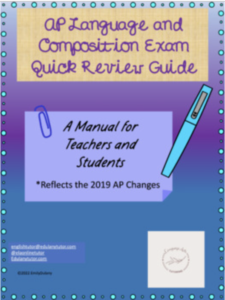
T-minus SIX weeks and counting until AP exams begin (gulp!). If you’re like many students in AP classes, you may start feeling the nerves grow as the dates approach for these testing weeks. Reviewing for the test does not need to be scary IF you have some direction and helpful reminders. In the coming weeks, I’m going to tackle some of the top challenges that students face when taking (and preparing to take) the AP Language and Composition Exam. In each post, I’ll focus on a different skill or review concept as we work together to get you ready for the exam. The month of May will be here before you know it, but you’ll be ready with helpful strategies by your side.
This Week’s Skill: Style

When an author writes, they must ask themselves many questions. What am I going to say? Why am I writing this? Who is this for? When will this be read? Each question is important, yet when we read their writing, how often do we slow down to really think about what went into the creation of the piece. Well, in an AP English class, you most likely spend a lot of time analyzing this. Just as the author considers many elements when crafting their sentences, we as readers must consider many elements as we read and analyze what they wrote. The AP Language and Composition Exam expects a great deal of analysis from students, and this can be challenging when students need to step into the shoes of the author for a moment and contemplate what they were thinking as they wrote. The good news is the AP exam will provide some context in the prompt to help identify the author’s background and the author will give a few clues as to what they were trying to accomplish as they wrote the piece. 
So, let’s break down the style component of this test. This exam requires students to read and comprehend non-fiction passages in order to complete approximately 45 multiple-choice questions (and quickly!). The reader must consider the rhetorical features that the author uses in order to get their purpose across to readers. The style of a passage refers to the author’s choices in diction (word choice), syntax (sentence structure), figurative language (devices that focus on developing meaning in words and phrases). It is hard to focus on these elements quickly, so annotation is vital. As you read the passages, make quick codes for yourself in the margins to note where you notice the subject (main idea) of the passage, the occasion, the audience, and the purpose. If other aspects of the passage jump out to you as you read it, note these as well (any figurative language or devices used to get the author’s point across), but make sure to note the other items first as you’ll most likely focus on this when answering questions.
For example, look at this beginning excerpt from William Faulkner’s Nobel Prize acceptance speech in December of 1950:
Ladies and gentlemen,
I feel that this award was not made to me as a man, but to my work – a life’s work in the agony and sweat of the human spirit, not for glory and least of all for profit, but to create out of the materials of the human spirit something which did not exist before. So this award is only mine in trust. It will not be difficult to find a dedication for the money part of it commensurate with the purpose and significance of its origin. But I would like to do the same with the acclaim too, by using this moment as a pinnacle from which I might be listened to by the young men and women already dedicated to the same anguish and travail, among whom is already that one who will some day stand here where I am standing.
What do you notice about this portion? What is the author’s purpose overall? What tone does Faulkner take and how does that impact the way the piece is delivered? While the answers to these questions could overlap a bit, you could note the personal connection Faulkner is making to his audience with his choice of words (“I feel,” “you,” “I would”). He is ultimately reaching out to those trying to capture the award he just received. People listening to this would take note of this and listen to his message because of the advice he offers. His tone is formal, but he connects directly with his audience in a personal way with his choice of words.
![]()
If this were an actual speech used on the AP test, multiple-choice questions may focus on the effect of the piece overall, the rhetorical situation, or the claims Faulkner makes. Likewise, in writing a rhetorical analysis essay about this passage, a student could discuss and choices this speaker makes in developing the message he wants to convey. Focusing on the style, or the way the passage is written, sounds tedious, but all it takes is simply identifying what the author is doing with the piece. What is their intention and how are they conveying that intention to their audience with words? You have the skills to notice this because you’ve most likely been analyzing ideas like these in literature since elementary or middle school. All you must do now is capture where it’s happening in the piece. Again, annotating helps a tremendous amount with this.

Ultimately, you want to consider every feature the author uses to write and notice if you are asked multiple-choice questions about these features. Scan the questions on the test to get a sense of what you’re looking for within the passage. Don’t guess as to what the author is feeling, but rather use the clues found within the passage (and in any background information provided) to analyze the author’s choices.
Keep practicing with any samples you are given in class and check the College Board information for practice as you get closer to the test. If you also want an AP Quick Review Guide, you can find one available on my TeachersPayTeachers site.